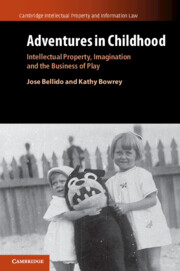Book contents
- Adventures in Childhood
- Cambridge Intellectual Property and Information Law
- Adventures in Childhood
- Copyright page
- Contents
- Figures
- Acknowledgements
- Abbreviations
- Introduction
- 1 Commercialisation and the Innocent Child
- 2 Books, Toy Books and the Artfulness of Consumption
- 3 Instructions for a Successful Boy
- 4 Animated Properties
- 5 Licensing Gone Wrong
- 6 The Rise of Merchandising Agencies
- 7 Troubles at the British Broadcasting Corporation
- Conclusion: Unsuitable for Children
- Index
- Cambridge Intellectual Property and Information Law
Conclusion: Unsuitable for Children
Published online by Cambridge University Press: 30 June 2022
- Adventures in Childhood
- Cambridge Intellectual Property and Information Law
- Adventures in Childhood
- Copyright page
- Contents
- Figures
- Acknowledgements
- Abbreviations
- Introduction
- 1 Commercialisation and the Innocent Child
- 2 Books, Toy Books and the Artfulness of Consumption
- 3 Instructions for a Successful Boy
- 4 Animated Properties
- 5 Licensing Gone Wrong
- 6 The Rise of Merchandising Agencies
- 7 Troubles at the British Broadcasting Corporation
- Conclusion: Unsuitable for Children
- Index
- Cambridge Intellectual Property and Information Law
Summary
The book’s conclusion returns to the commercialisation of Alice in Wonderland by considering the controversy surrounding Jonathan Miller’s 1966 Alice film, screened by the BBC. The art film offered a surreal Victorian dreamscape of childhood, as much for an erudite adult audience as for a child audience. It was a representation that was highly unlikely to have concerned Dodgson at all but was considered controversial enough to provoke public responses of hostility and incomprehension, attracting protests about a liberality that ought to be banned. This controversy allows us to reference changed understandings of childhood. Particularly in light of Disney’s rendition of Alice and the development of the BBC’s institutional role in the 1960s, where there was ready acceptance of the children’s department remit, with the imagery of the child overlaid with expectations of marketing and age-appropriate merchandise. Many issues that vexed the BBC in this period are rooted in the paradox that underpins the whole book: the tension between exploitation and innocence; family and market; public and private; and the normalisation of the logic of commercialisation tied to intellectual property.
Keywords
- Type
- Chapter
- Information
- Adventures in ChildhoodIntellectual Property, Imagination and the Business of Play, pp. 281 - 292Publisher: Cambridge University PressPrint publication year: 2022

